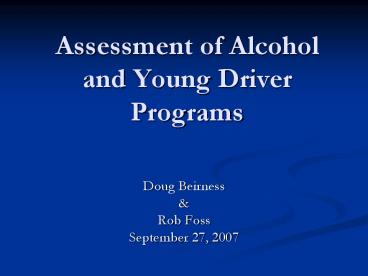Assessment of Alcohol and Young Driver Programs PowerPoint PPT Presentation
1 / 29
Title: Assessment of Alcohol and Young Driver Programs
1
Assessment of Alcoholand Young DriverPrograms
- Doug Beirness
- Rob Foss
- September 27, 2007
2
Overview
- Alcohol Programs
- Background
- Stages of Impaired Driving
- Opportunities for Intervention
- Recommendations
- Young Driver Programs
- Background
- Stages of Young Drivers
- Opportunities for Intervention
- Recommendations
3
Alcohol Programs
- LA alcohol crash rates follow national trend
- Among the top 10
- In 2006, 475 deaths 48 of all (national 41)
- 10.5 deaths/100,000 population
- 75 higher than national rate of 5.9
- Over past several years, little change
4
Figure 1 The Stages of Drinking and Driving
Stage 1
Stage 2
Stage 3
Prosecution
Arrest
AlcoholConsumption
Sanctions
Impaired Driving
Crash/Injury
Programs
Driving
Safe Arrival
Medical Treatment
Identification andApprehension
Prevention
Dealing withOffenders
Opportunities for Intervention
5
Stage 1
AlcoholConsumption
65 drink
22 drive after drinking 1 Billion Trips
Driving
90 drive
6
Stage 2
Arrest
1 in 445 arrested 1.5 million
Impaired Driving
Crash/Injury
1 in 30,000 fatal 17,000
Safe Arrival
All the rest
7
Stage 3
Prosecution
Sanctions
Programs
Medical Treatment
8
Opportunities for Intervention
- Stage 1 Primary Prevention
- Information, awareness
- General deterrence
- Mass media
- Cost-benefit ratio 17
- Clear, simple messages, fresh
9
Primary Prevention
- Youth Programs
- Two objectives
- 1. Keep safe now
- 2. Learn skills to keep safe later
- Speakers
- Raise awareness briefly
- LSU Campus-Community Coalition for Change
- Comprehensive program to foster safer community
- Change social norms, support safe/healthy behavior
10
Primary Prevention
- Alcohol Policies
- Underage drinking e.g., Cops in Shops
- Zero tolerance for young drivers
- 18 year-olds in bars
- Server training/server intervention
- Encourage culture of moderation
11
Primary Prevention
- Alternative Transportation
- Safe Ride services
- Subsidized taxis
- Designated drivers
12
Identification and ApprehensionSecondary
Prevention
- Primarily responsibility of enforcement
- Maintain focus on fundamental principles/objective
s - Checkpoints increased perception of likelihood
of being caught - Saturation Patrols catch impaired drivers in
most likely locations - Breath test refusals
- Training
13
Dealing with OffendersTertiary Prevention
- DWI code review
- Prosecutor training
- Diversion
- DWI courts
14
Dealing with OffendersTertiary Prevention
- Specific Deterrence
- Sanctions retribution, incapacitation,
rehabilitation and restitution - Victim Impact Panels
- Ignition Interlock Programs
- Rehabilitation programs
- Screening, assessment, treatment
- Brief interventions
15
A Process for Change
- AASHTO Model
- Simplified 4-step process
- Select committee to identify key features of
problem and establish goals - Identify strategy and action plan
- Implement the plan
- Evaluate it
16
Recommendations
- General
- Establish a Vision
- Focus on concepts that lead to programs
- Set meaningful, challenging targets consistent
with the vision - Require evaluation of all programs
17
Recommendations
- Legislation
- DWI code review
- Work to remove barriers to effective system
- Alcohol Policy
- Develop comprehensive alcohol strategy that will
move from a culture of indulgence to a culture
of moderation
18
Recommendations
- Primary Prevention
- High priority to comprehensive programs
- Low priority to didactic programs
- Link media campaigns to other initiatives
- Alternative transportation
- Designated drivers
19
Recommendations
- Identification and Apprehension
- Training of enforcement personnel
- Use checkpoints to enhance perception of risk of
being arrested - Target one community for concentrated enforcement
program
20
Recommendations
- Dealing with Offenders
- Conduct a review and evaluation of diversion
programs - Evaluate DWI courts
- VIP should be low priority
- Facilitate expansion of interlock programs
- Develop test program of screening/assessment/tre
atment of DWI offenders - Training of criminal justice personnel
21
Young Driver Programs
- Motor vehicle crashes are the leading cause of
death among youth - In LA, 65 drivers 40 passengers aged 15 19
die each year - 30 of people killed in young driver crashes are
other road users - Little change over past 10 years
22
Young Drivers
- Learning to drive is complicated
- Cognitive activity that involves social
interaction with strangers at high speed - Can teach rules of the road and vehicle handling
skills - Safe driving requires host of higher-order skills
- Eventually learn over few years, but price is
high - GDL opportunity to gain experience in lower risk
conditions
23
Stages of Young Drivers
- Pre-driving
- Observation of others primarily parents
- Novice
- Behind the wheel
- Instruction
- Practice
- (In)Experienced Young Driver
- Licensing
- Acquiring experience
24
Opportunities for Intervention
- Pre-driving
- Encourage parents to model safe driving practices
- Novice
- Formal driver training
- Parental involvement in driver training
- (In)experienced young driver
- Licensing
- Enforcement
25
Young Driver Programs
- Primarily alcohol-oriented
- LSU CCCC focus on alcohol but broader base of
high-risk/unhealthy behaviors as well - One-shot didactic programs have little impact
- Gaps
- Seat belt programs
- Improved Graduated Driver Licensing
26
Recommendations
- General
- Focus on concepts rather than programs
- Broaden relationship with LSU
- Develop strategic approach to young driver
programs - Policy/legislation
- Upgrade GDL
- Create expert panel
27
Recommendations
- Program activities
- Develop programs to involve parents in licensing
- Help parents with new driver supervision
- Help parents continue working with newly licensed
drivers - Encourage parents to think carefully about
vehicle choices
28
Recommendations
- Program activities
- Ensure GDL conditions well known
- Publicize enforcement of underage drinking laws
and drink-driving laws - Publicize enforcement of seat belt laws
- Explore opportunities to collaborate with
universities to develop innovative approaches to
driver training
29
(No Transcript)

